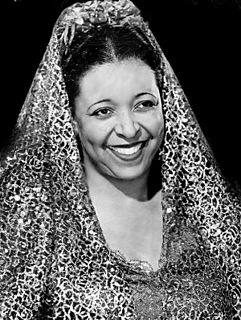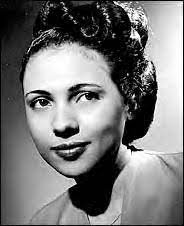Related Research Articles

Ethel Waters was an American singer and actress. Waters frequently performed jazz, swing, and pop music on the Broadway stage and in concerts. She began her career in the 1920s singing blues. Waters notable recordings include "Dinah", "Stormy Weather", "Taking a Chance on Love", "Heat Wave", "Supper Time", "Am I Blue?", "Cabin in the Sky", "I'm Coming Virginia", and her version of "His Eye Is on the Sparrow". Waters was the second African American to be nominated for an Academy Award. She was the first African American to star on her own television show and the first African-American woman to be nominated for a Primetime Emmy Award.

Oscar Devereaux Micheaux was an author, film director and independent producer of more than 44 films. Although the short-lived Lincoln Motion Picture Company was the first movie company owned and controlled by black filmmakers, Micheaux is regarded as the first major African-American feature filmmaker, a prominent producer of race films, and has been described as "the most successful African-American filmmaker of the first half of the 20th century". He produced both silent films and sound films.

The race film or race movie was a genre of film produced in the United States between about 1915 and the early 1950s, consisting of films produced for black audiences, and featuring black casts. Approximately five hundred race films were produced. Of these, fewer than one hundred remain. Because race films were produced outside the Hollywood studio system, they were largely forgotten by mainstream film historians until they resurfaced in the 1980s on the BET cable network. In their day, race films were very popular among African-American theatergoers. Their influence continues to be felt in cinema and television marketed to African Americans.

A Daughter of the Congo is a 1930 race film directed, written and produced by Oscar Micheaux. The film is loosely based on the novel The American Cavalryman (1917), by African-American novelist and playwright Henry Francis Downing. It is considered a lost film.
The House Behind the Cedars is a 1927 silent race film directed, written, produced and distributed by the noted director Oscar Micheaux. It was loosely adapted from the 1900 novel of the same name by African-American writer Charles W. Chesnutt, who explored issues of race, class and identity in the post-Civil War South. No print of the film is known to exist, and it is considered lost. Micheaux remade the film in 1932 under the title Veiled Aristocrats.
The Symbol of the Unconquered is a 1920 silent "race film" drama produced, written and directed by Oscar Micheaux. It is Micheaux's fourth feature-length film and along with Within Our Gates is among his early surviving works. The Symbol of the Unconquered was made at Fort Lee, New Jersey, and released by Micheaux on November 29, 1920. A print of the film is extant at the Museum of Modern Art in New York. The film is based on the way perceptions of race shape human relationships.
Pearl Bowser is an author, television director, film director, producer, and film archivist. She is the author of a book on the first ten years of the career of Oscar Micheaux, an African-American who directed 40 "race pictures" between 1918 and 1940. She is thus credited for having helped rediscover some of Oscar Micheaux's rare surviving films. She is the founder of African Diaspora Images, a collection of visual and oral histories that documents the history of African-American filmmaking. Part of her journey includes teaching young people film in the 1960s and 1970s.
Birthright is a 1939 American film directed, co-produced and co-written by Oscar Micheaux. Carman Newsome stars in the 1939 film as a black Harvard graduate facing racism and discrimination after he returns to his small hometown in Tennessee, where he hoped to develop a school similar to Tuskegee Institute or Hampton Institute, both historically black colleges.
Ethel Moses was an American actress and dancer, billed as "the black Jean Harlow". She is best known for working in films by Oscar Micheaux.

Underworld is a 1937 gangster film directed by Oscar Micheaux, about a recent graduate from an all-black college who moves from the American South to Chicago and gets swept into the criminal underworld. The film was adapted from the short story "Chicago After Midnight" by Edna Mae Baker. Among its stars are Ethel Moses, a Micheaux regular, and Oscar Polk, best known for his appearance in Gone with the Wind two years later.
Easy Street is a 1930 American film by Oscar Micheaux, an African American filmmaker. It features an African American cast. Known as the last silent achievement in his filmography, the film is considered lost. The plot reportedly revolved around a group of con artists trying to seize the savings of an old man.

Laurence Criner occasionally credited as J. Lawrence Criner, was an actor in the United States. An African-American, he had numerous film roles including as the male lead and star.
The Spider's Web is a 1926 Oscar Micheaux film starring Evelyn Preer. It was remade in 1932 as The Girl from Chicago.
The Broken Violin is an American silent film directed by Oscar Micheaux, released in 1928.
Carl Mahon was an actor in the United States. An African American, he had several film roles including a starring role in the 1932 film The Girl from Chicago
Andrew S. Bishop (1894–1959) was an actor on stage and screen. He and Cleo Desmond drew adoring fans to their theatrical performances. He starred in several of Oscar Michaux's African American films.

African American cinema is loosely classified as films made by, for, or about Black Americans. Historically, African American films have been made with African-American casts and marketed to African-American audiences. The production team and director were sometimes also African American. More recently, Black films featuring multicultural casts aimed at multicultural audiences have also included American Blackness as an essential aspect of the storyline.
Ten Nights in a Barroom is an American film released in 1926. The film had a temperance theme and an African American cast. It followed on Timothy Shay Arthur's 1854 novel Ten Nights in a Bar-Room and What I Saw There and William W. Pratt's play, as well as earlier film adaptations albeit with white casts. A man's drinking causes him to lose money, his business, and his daughter. The film has been restored and is archived at the Library of Congress. Charles Gilpin stars. The film was released during the Prohibition era. Roy Calnek directed.
Harry Henderson was an actor in theater and films in the United States. He made four films with the Colored Players Film Corporation. He was also cast in several Oscar Micheaux films and had a starring role in the film melodrama The Scar of Shame. He portrays a wealthy concert pianist in the film. He also had a lead role in the 1926 film The Prince of His Race.

Dorothy Van Engle was an American actress who performed throughout the 1930s. She starred in Oscar Micheaux films, including Murder in Harlem and Swing!.
References
- ↑ Reid, Mark A. (June 4, 2005). Black Lenses, Black Voices: African American Film Now. Rowman & Littlefield. ISBN 9780742526426 – via Google Books.
- 1 2 "Lobby Card for Temptation". National Museum of African American History and Culture.
- ↑ https://academicworks.cuny.edu/gc_etds/1928/ page 47
- ↑ McCann, Bob (December 21, 2009). Encyclopedia of African American Actresses in Film and Television. McFarland. ISBN 9780786458042 – via Google Books.
- ↑ "Photo Archive of Alfred "Slick" Chester, African American Film Actor—the "Colored Cagney"—and Black Filmmakers Hall of Fame Inductee by Alfred "Slick" Chester, 1900–1978 on Ian". Ian Brabner, Rare Americana, LLC (ABAA).